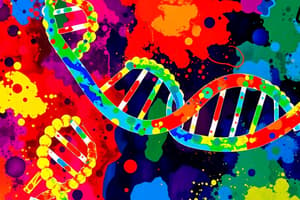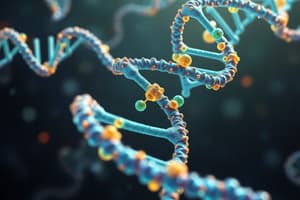Podcast
Questions and Answers
What is the primary process described by the Central Dogma of molecular biology?
What is the primary process described by the Central Dogma of molecular biology?
- Replication of DNA into RNA
- Transformation of protein into DNA
- Transcription of DNA into RNA (correct)
- Translation of RNA into protein (correct)
Which of the following accurately represents the flow of information as dictated by the Central Dogma?
Which of the following accurately represents the flow of information as dictated by the Central Dogma?
- DNA -> RNA -> Protein (correct)
- Protein -> RNA -> DNA
- RNA -> DNA -> Protein
- DNA -> Protein -> RNA
Which molecular process involves the synthesis of RNA?
Which molecular process involves the synthesis of RNA?
- Translation
- Mutation
- Transcription (correct)
- Replication
What is NOT a part of the Central Dogma regarding genetic information?
What is NOT a part of the Central Dogma regarding genetic information?
In the Central Dogma, what role does messenger RNA (mRNA) play?
In the Central Dogma, what role does messenger RNA (mRNA) play?
What is the primary function of DNA in the Central Dogma of molecular biology?
What is the primary function of DNA in the Central Dogma of molecular biology?
Which statement best describes the role of RNA in the Central Dogma?
Which statement best describes the role of RNA in the Central Dogma?
What is the process called by which information from DNA is transferred to RNA?
What is the process called by which information from DNA is transferred to RNA?
Which of the following best explains the flow of information in the Central Dogma?
Which of the following best explains the flow of information in the Central Dogma?
What role do proteins play according to the Central Dogma of molecular biology?
What role do proteins play according to the Central Dogma of molecular biology?
Flashcards
Central Dogma
Central Dogma
The flow of genetic information in biological systems.
Genetic Information
Genetic Information
A set of instructions that determine traits.
Molecular Biology
Molecular Biology
Study of biological molecules.
DNA
DNA
Signup and view all the flashcards
Protein
Protein
Signup and view all the flashcards
What is the Central Dogma?
What is the Central Dogma?
Signup and view all the flashcards
Transcription
Transcription
Signup and view all the flashcards
Study Notes
The Central Dogma of Molecular Biology
- Central dogma describes the flow of information in a cell, starting with DNA.
- DNA replicates to form more DNA.
- Information is then transcribed into RNA.
- RNA is then translated into protein.
DNA Structure
- DNA is a double-helix structure.
- Located in the nucleus and mitochondria.
- Composed of deoxyribonucleic acid.
- Contains nitrogenous bases: adenine, guanine, cytosine, and thymine.
- Carries genetic information.
RNA Structure
- Single-stranded.
- Located in the cytoplasm.
- Contains nitrogenous bases: adenine, guanine, cytosine, and uracil.
- Helps in protein synthesis.
Types of RNA
- Transfer RNA (tRNA): Transports amino acids to the site of protein synthesis.
- Ribosomal RNA (rRNA): Combines with proteins to form ribosomes, the site of protein synthesis.
- Messenger RNA (mRNA): Directs the amino acid sequence of proteins.
- Small nuclear RNA (snRNA): Processes initial mRNA to its mature form in eukaryotes.
- Small interfering RNA (siRNA): Affects gene expression; used to knock out genes being studied.
- Micro RNA (miRNA): Affects gene expression; important in growth and development.
Genetic Code
- A dictionary that corresponds to the sequence of nucleotides and sequence of amino acids.
- Set of rules that translates information from genetic material (DNA or RNA) into proteins.
- Coined by George Gamow.
- There are 20 amino acids.
- 61 codons code for 20 amino acids found in proteins.
- 3 codons do not code for any amino acid.
Types of Codons
- Sense codons: Code for amino acids.
- Signal codons: Code for signal during protein synthesis.
- Examples: AUG, UAA, UAG, and UGA.
- AUG is the initiation codon (codes for methionine in eukaryotes and formylmethionine in prokaryotes). -UAA, UAG, and UGA are termination codons (stop codons).
Anticodon
- Base sequence of tRNA that pairs with codons of mRNA during translation.
- Always present in RNA, but not in DNA.
- Written in the 3' to 5' direction.
- Some tRNA molecules have to pair with more than one codon.
Characteristics of the Genetic Code
- Triplet code: Three bases (codons) code for one amino acid.
- Comma less: No punctuation between codons.
- Non-overlapping: Each base is part of only one codon.
- The coding dictionary: Specific codons code for specific amino acids.
- Degenerate code: More than one codon can code for the same amino acid (redundancy).
- Universality of code
- Non ambiguity code
- Chain initiation code
- Chain termination codons
Protein Synthesis
- Process of producing proteins.
- Involves two processes: transcription and translation.
- DNA is used as a template to make mRNA.
- mRNA leaves the nucleus and goes to a ribosome.
- Ribosomes read the mRNA and build the protein.
Gene Regulation
- Regulation of gene expression.
- Includes a range of mechanisms used by cells to increase or decrease the production of specific gene products.
Mutation
- Sudden, heritable change in genetic material or character of an organism.
- Individuals showing the changes are known as mutants.
- Individuals showing an altered phenotype due to mutations are known as variants.
- Factors causing mutation are known as mutagens.
- Changes in base sequence of a gene are called gene mutations or point mutations.
Types of Chromosome Mutations
- Deletion: A piece of a chromosome is lost.
- Inversion: A chromosome segment breaks off, flips around backwards, and reattaches.
- Duplication: A gene sequence is repeated.
- Translocation: A part of one chromosome is transferred to another chromosome.
- Nondisjunction: Failure of chromosomes to separate during meiosis causes a gamete to have too many or too few chromosomes. (Down syndrome, Turner syndrome, Klinefelter's syndrome are examples of disorders caused by this)
Types of Gene Mutations
- Point mutations: Change of a single nucleotide. (includes deletion, insertion or substitution of one nucleotide)
- Frameshift mutations: Inserting or deleting one or more nucleotides. Changes the reading frame.
Human Gene Therapy
- Introduction of genes into existing cells to prevent or cure diseases.
- Technique to correct defective genes responsible for disease development.
- First approved gene therapy experiment on September 14, 1990, in the US treating Ashanti DeSilva for ADA-SCID
Types of Gene Therapy
- Somatic cell gene therapy: Therapeutic genes transferred to somatic cells; not inherited.
- Germ-line gene therapy: Therapeutic genes transferred to germ cells; heritable.
Approaches in Gene Therapy
- In vivo gene therapy: Direct delivery of genes into the body cells.
- Ex vivo gene therapy: Transfer of genes to cultured cells, then reintroduced into the body.
Examples of Gene Therapy
- Ex vivo: Correct deficiency of enzyme adenosine deaminase (ADA), in patients suffering from SCID-Severe Combined Immunodeficiency.
- In vivo: In patients with cystic fibrosis, the cystic fibrosis transmembrane regulator (CFTR) is absent, leading to the accumulation of sticky mucous. In the therapy, the defective gene replacement is carried out using an adenovirus vector
Other gene therapies
- Gene augmentation therapy: Most common, where foreign genes replace missing or defective genes.
- Gene inhibition therapy: Done to block overproduction of specific proteins using antigene or antisense therapy.
Disadvantages of gene therapy
- Long-lasting therapy is not achieved due to rapid dividing cells.
- Immune responses to transferred genes.
- Toxicity from viral vectors used.
- Disorders caused by defects in multiple genes cannot be treated effectively using gene therapy.
Advantages of gene therapy
- Potential to eliminate and prevent hereditary diseases.
- Possible cure for diseases like heart disease, AIDS, and cancer.
- Chance for individuals with genetic diseases.
- Eradicating diseases in future generations.
Studying That Suits You
Use AI to generate personalized quizzes and flashcards to suit your learning preferences.




